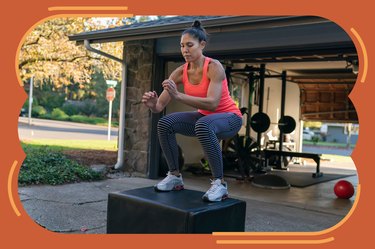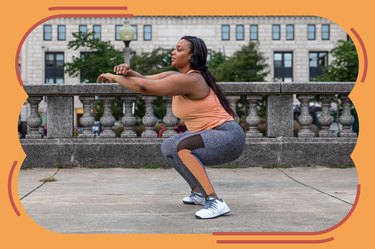
What muscles do burpees work? More or less, all of them. This high-impact, full-body exercise leaves virtually no muscle untapped — working your legs, hips, core, chest, shoulders and arms.
One of the hardest body-weight exercises out there, burpees essentially involve lying stomach-down on the ground, then coming back up to standing, says exercise physiologist and strength coach Pete McCall, CSCS, CPT, host of the All About Fitness Podcast.
Video of the Day
Video of the Day
"This is a true full-body exercise that engages and strengthens almost every muscle from head to toe," McCall says. That's because the movement combines a series of exercises — an air squat, high plank, push-up and jump squat — into one movement. Each of those parts work different muscles.
Quads, Glutes, Hamstrings
"At the start of the rep, when you initially squat down, you engage your quads, glutes and hamstrings," says Connecticut-based personal trainer Nika Shelby, CPT. Your quads and glutes work eccentrically, lengthening to control your motion. Your hamstrings contract to bend your knees.
Core, Shoulders
When you shift from the bottom of the squat into a high plank, your core muscles (transverse abdominis) and shoulders (deltoids and rotator cuffs) get called into action. Together, they stabilize your lower back and shoulders, both of which can be prone to injury.
Chest, Triceps
If you incorporate a push-up into the exercise, your chest and triceps put in work. (And if you focus on lowering slowly into each push-up, you can also work your lats, traps and biceps eccentrically.)
Glutes, Quads, Calves
Finally, when you jump your feet back up to your hands — and then launch your body into the air — your calves, quads and glutes work hard to extend your ankles, knees and hips.
Are Burpees Right for You?
Traditional burpees aren't appropriate for every person or body. They're high-impact and can place a lot of stress on the wrists and knees. Also, if you have high or low blood pressure, burpees could worsen your symptoms.
Listen to your body
— and your doctor. You can try a burpee modification, burpee alternative or opt for another exercise altogether, like a squat thrust.
4 Other Burpee Benefits
1. Increased Power Output
The burpee — and nearly all burpee variations — is plyometric exercise, which basically means it's explosive. "Plyometric exercises help activate and strengthen your fast-twitch muscle fibers, which are the muscle fibers we primarily lean on for explosive, power-based movements," Shelby says.
While plyometrics are especially important for professional athletes, they're great for anyone who wants to build a little oomph in their sport, be it swimming, skiing, running, soccer, tennis, climbing or anything else.
"Training those fast-twitch muscle fibers is never going to hurt a person's athletic performance and training," Shelby says.
2. Muscular Endurance
Usually, burpees are performed back-to-back in rapid succession with the goal of hitting a certain rep count or time duration. As your reps increase, you transition from building power to building muscular endurance.
Muscular endurance is how long your muscles can work before tuckering out and is largely controlled by your slow-twitch, aerobic muscle fibers.
3. Functional Strength
One other major benefit of burpees is strength-building. As mentioned above, burpees require you to perform push-ups and squats — both classic strength exercises.
Plus, the ability to get yourself up off the floor is an important skill for overall health and day-to-day function, Shelby says. That's true if you want to get play on the floor with your kids, scrub the baseboards or have an accidental fall.
"Someone who has been working their pushing muscles, as they do in this move, is going to be much more likely to get up off the ground when they fall than someone who has not been working those muscles," she says.
4. Improved Cardio
In addition to training your upper- and lower-body muscles, burpees can improve the health of your heart and lungs. Burpees are a type of anaerobic training — high-intensity activity that's short in duration and requires your body to produce energy without the assistance of oxygen.
"Your heart is responsible for moving blood around your body, when we strengthen the heart through exercises like this one, you're helping the heart become more efficient at pumping blood around the body," McCall says.
Bonus: Unlike other types of cardiovascular exercises, it requires absolutely no equipment and only a few square feet of floor space. That means it's available for people without a gym membership, as well as those on the go.
Do Burpees Help You Lose Weight?
The intensity of burpees and the number of muscles needed to perform this exercise results in a large caloric expenditure. Because you lose weight by burning more calories than you consume, burpees may help you lose weight, as long as you also consume a healthy, calorie-reduced diet.
- ExRx.net: "Burpee (Advanced)"
- ExRx.net: "Burpee"
- Harvard Health Publishing: "Calories Burned in 30 Minutes for People of Three Different Weights"
- ExRx.net: "Push-Up"
- American Fitness Magazine: "How to Modify Like a Pro"
- ExRx.net: "Squat Jump"
- American Council on Exercise: "5 Benefits of Compound Exercises"
- Journal of Strength and Conditioning Research: "The effect of high-load vs. high-repetition training on endurance performance"



